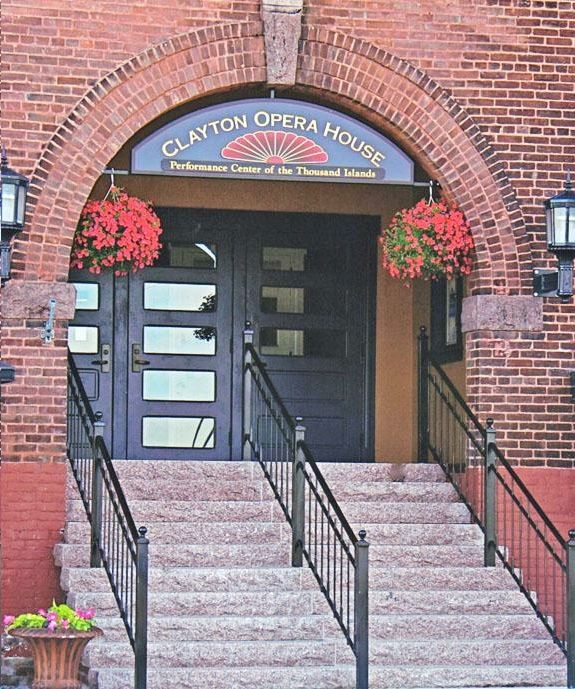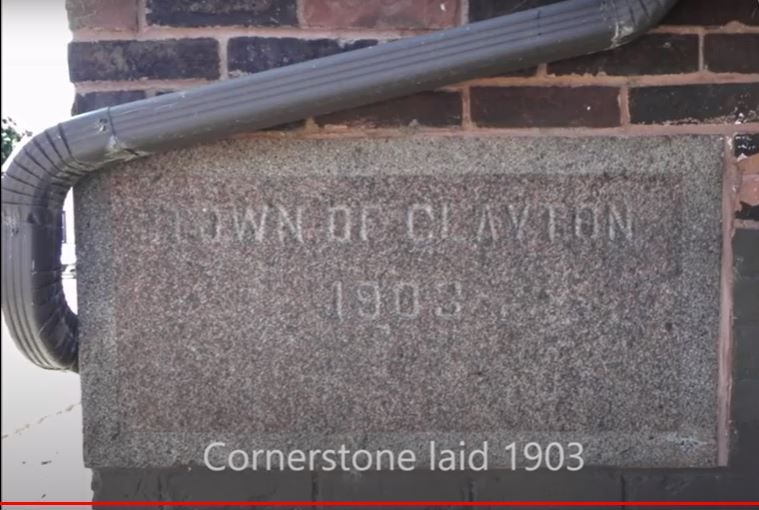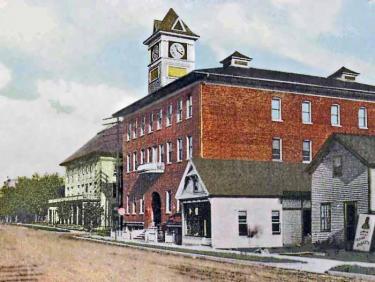Clayton's 150th: Clayton's Opera House
by: Julie Garnsey
Editor's Note: A few weeks ago a friend called to ask if I knew very much about the Clayton Opera House and either way, would I like to do an article about it? Not a strange question and it just so happens that Julie Garnesy, the Opera House’s Executive Director, gave an in-depth talk about the origins of this wonderful facility for the Clayton 150th Anniversary Celebrations in collaboration with the Thousand Islands Museum and the Town & Village of Clayton Historian. The complete talk was recorded on YouTube, but here are Julie’s highlights. You’ll also note that in places the building is referred to as the Opera House and in others, the Town Hall. See the section on Town Hall for the explanation!
Julie Garnsey has been Executive Director of the Thousand Islands Performing Arts Fund, Inc. at the Clayton Opera House since April 2014. During this time, their programming has been increased significantly to offer more year-round opportunities. They have an active Arts in Education program which provides opportunities for students to see performances at the Opera House free of charge. The Opera House has three full-time and one part-time employee, 13-15 Board Members and over 70 volunteers.
The Clayton Opera House
The cornerstone of the Opera House was laid in August 1903 and the building was completed in July 1904. It was constructed on the corner of Water (now Riverside Drive) and Merrick Streets, which was the site of the once-thriving Johnston Shipyard (1). Its architect was Frank T. Lent, born in Poughkeepsie, N. Y, and had an office in Clayton. Lent also designed a number of homes on islands and in Gananoque, ON. George R. Kenyon was its builder; he was the grandfather of former Clayton Mayor Dale Kenyon, Damon Kenyon, Ann Kenyon Storandt, and Gordon Cerow, Jr.

The edifice was electrified and heated by steam from the pumping station across the street. In 1933, a boiler that burned pea coal was installed in the basement of the Opera House, and in 1938, the fuel was changed to oil. The pumping station and coal sheds also were constructed by George R. Kenyon.

The Opera House was built for the Town of Clayton at a cost of $15,000. Before they could complete the building, being low on funds, they made an arrangement with the members of Masonic Lodge No. 296 and with Hollister B. Dewey. The Masons agreed to pay for the cost of the third floor, provided that they could use that floor for their meetings. H.B. Dewey agreed to finish the basement, provided he could have a long-term lease to use for his furniture and undertaking business. In 2000, the Masons moved out of the Opera House. Their lease with the Town of Clayton was not renewed in 1993, but they were allowed to stay there until they united with another Lodge. At that time, the youngest member was 64 years old. With no elevator in the building, these elderly men found the stairs difficult to manage. Eventually, they joined the Mason’s Lodge in Depauville and stored their furniture at a Lodge in Chaumont.
Raked Stage
The Opera House had a seating capacity of 750, and at the time, had the largest stage in Jefferson County. It was called a raked stage because it sloped toward the footlights, as did the scenery. The stage was built that way purposely, in order to give the audience the optimum view of the stage. Five sets of scenery were kept in the basement, where five dressing rooms were located. The sceneries came from the Ackerman Studio in New York City.
The Clock Tower & WWII
The Clock Tower of the Town Hall was donated by the Civic Club in 1905 and a four-sided clock, which struck every half hour, was donated by the H. B. Dewey family. Also, in 1905, a bell was donated to the Village of Clayton by the late A. H. Vandergrift of Washington, D.C., who had a palatial summer home on Long Rock Island. The bell, operated by the clock mechanism, rang the hours for a great many years.
During World War II, the clock was removed so the tower could be used as an observation tower. A walk around with a protective railing was built on each side of the tower. Men were airplane spotters at night and women during the day. After the war, it was discovered someone had donated the gears, counterweights and other parts of the clock to the scrap drive as another patriotic gesture. However, the bell was preserved and is on display in the area of the Town of Clayton Offices, in the basement of the Opera House.

The Weathervane
In 1920, according to Grace Louise Frink Reinman, a polished brass weathervane, which depicts the traditional large fish of the area, the muskellunge, was crafted by Carl Frink, founder of the Frink Snow Plow Company. At that time Mr. Frink had a vulcanizing and automobile tire sales business on Riverside Drive where the US Customs office was located. The weathervane was donated to the Village of Clayton by Augusta (Lottie) Mann in memory of her husband after he died. The weathervane was an aid to fishermen, showing them which direction the wind was blowing. It had its first home on top of the Walton House where Mr. and Mrs. Mann had a suite when they came to Clayton for fishing trips. The hotel was located on the corner of Riverside Drive and James Street where Mars Pizza is now located. After the Walton House was torn down in 1930, the weathervane was placed on the roof of the Opera House.
First Entertainment
The very first entertainment in the Opera House was presented by the Traveler’s Club in early January 1904. It consisted of a quartet and an elocutionist. The first big dance held there was the Fireman’s Ball on February 10, 1904 with music provided by Whittier & Lapatra’s orchestra.
Well known celebrities graced the stage of the Opera House. May Irwin of vaudeville fame, as well as actress Lillian Russell. William Danforth was considered one of the greatest comedians on the American stage. He was known especially for his performances in Gilbert and Sullivan and Victor Herbert operas. He and his actress wife, Norma Kopp, summered in the Thousand Islands for many years, before they bought their house on Murray Isle in 1926. Dick Munro, Bill Danforth, and Bill Munro are grandsons of William and Norma Danforth.
Tenants
The library was the first tenant of the Opera House in 1904. They occupied the 2nd floor. Their utilities were free and their staff members were volunteers. Their only expenses were for books and working materials.
The basement of the Opera House has housed many businesses over the years. The previously mentioned Dewey’s Furniture Store and Funeral Parlor and, on the same side as the furniture store, the Western Union telegraph office opened in 1945 and was managed by 12 year old Lois Dewey. Other businesses located there were: Jeffers Furniture and Dry Goods, Gates Jewelry, Austina’s Dress Shop, John Pruzan’s Boston Clothing Store, and the Tip Top Diner, which was managed by Ernie and Marion Russell from 1954 to 1975. In the 1920’s, Louis Leonard operated a Beauty Salon on the west side of the basement.
Town Hall
The Opera House also was referred to as the Town Hall because it was intended to be used for a variety of community functions, such as: Commencement exercises, the annual Fireman’s Ball, Government Employment office, Youth Center, Radio Club meetings, etc. The Grand Army of the Republic celebrated their elaborate Memorial Day ceremonies there and large quantities of lilacs decorated the hall.
In the 1920’s, the Clayton High School used the main floor of the Opera House as a basketball court. The baskets were suspended from the stage and the opposite balcony. The High School at that time was where the Municipal Building is and was not large enough to handle extra-curricular activities. A rather unusual use of the Town Hall was for the annual Poultry Show. The late Baptiste Diabo staged chicken-plucking exhibitions there. He was considered the champion of Jefferson County and could pluck a chicken in less than a minute. Also, White’s and Franklin’s “Old Time Medicine” shows packed the Town Hall every time. They advertised their wares, which they claimed cured everything from a sore toe to rheumatism and apoplexy.
End of an era and the start of another
For a town the size of Clayton, it is unusual but impressive to have three museums: The Thousand Islands Museum, the Antique Boat Museum, and the Handweaving Museum and Arts Center (now the Thousand Islands Art Center). The Thousand Islands Museum nurtured all three under its charter in the Opera House for several years. They have all grown, moved to independent buildings, thrived, and gained strong reputations in Northern New York and nationwide.
The Chamber of Commerce was housed in the basement of the Opera House from 1970-1992 before moving to 510 Riverside Drive.
In 1950, the theater company called the Thousand Islands Playhouse moved into the Opera House for five summers, July through Labor Day. They had a professional acting group from New York City and presented such plays as “Streetcar Named Desire”, “Design for Living”, “Arsenic and Old Lace”, “Tobacco Road”, and “Seven Year Itch”.
During the 1970’s, no theater-related activities were held because the Thousand Islands Museum was revamping the second floor after the Shipyard Museum and the Craft School opened in their new locations.

John Burt, a 5th generation summer resident, produced popular plays between 1987 and 1989 including "Wind in the Willows", "River Song Revue" and the "Slick of 76", which debuted on July 3, 1987. In 1990, Michael Kinnie brought comedy shows from his Sackets Harbor Playhouse to the Opera House.
During a period of 10-15 years, starting in the late 1970’s, a group of enthusiastic local teachers and others formed a group called the Thousand Islands Community Theater. There were close to 50 participants. Coinciding with the weekend of the annual Clayton Christmas parade, this group put on a Christmas play with music, which presented a different theme each year.
Then in 2002, after a considerable number of meetings, discussions, and negotiations, the Thousand Islands Museum decided to move to a different location so that the Opera House could become a true and vital Opera House, a Performing Arts Center of which Northern New York could be proud. The inaugural concert of the Opera House on July 29, 2002 featured the P.I. Tchaikovsky Bolshoi Symphony Quartet and was a tremendous success.
TIPAF/Town of Clayton Partnership
In 2003, the Thousand Islands Performing Arts Fund (TIPAF) and the Town of Clayton contractually agreed upon the renovation and revival of the Opera House.
The renovations were completed in 2007 and TIPAF has managed the upper three floors of the Opera House since that time. TIPAF raised $3.25 million from private donations and grants for the renovations and remains in an agreement with the Town of Clayton to manage the Opera House. The Town still occupies the basement with their offices.


Today, TIPAF is a non-profit organization that is run by a Board of Directors of 13-17 members. We currently have three full-time employees, one part-time employee and approximately 70 volunteers. We have over 250 Patrons who donate yearly to our organization to help us continue our mission. Additionally, we have businesses that support us through show sponsorships and other donations.
There will be more than 80 events scheduled in 2022 that include both TIPAF events and rentals – yes, right here in the Clayton Opera House. We thank all those who played a role in building the Clayton Opera House so many years ago, and we hope this year you will come and visit. Often!
[Footnote: 1. See also TI Life March issue, for article by Richard Palmer about Captain Simon G. Johnston who built his shipyard on the site of the Clayton Opera House.]
Note: in 2003 the history of the Clayton Opera House was recorded in the book "Clayton Opera House Centennial History 1903 - 2003" edited by Gay Wright. Grace Louise Frink Reinman's recollections were captured in this book. We are always grateful for those who do record their memories as history is so easily lost.
[Header photograph of the Clayton Community Band by Erin McCarthy Green]
By Julie Garnsey
Julie Garnsey served in the US Navy for 24 years, as a Hospital Corpsman, retiring in 2007. From 2009 to late 2013, she was Director of the Hawn Memorial Library in Clayton. She has a Bachelor of Science Degree in Health Care Management. Julie serves on the Clayton Chamber of Commerce and Thousand Islands Museum Boards. She volunteers for events with the Clayton Chamber of Commerce and Save The River and has served as a panelist for the St. Lawrence County Arts Council and the New York State Council for the Arts. Julie and her husband also run a non-profit large animal sanctuary located in Depauville, New York called Garnsey’s Feral Acres. And if you look closely at the Community Band photographs during the last ten years, you'll see Julie playing clarinet.






Please click here if you are unable to post your comment.